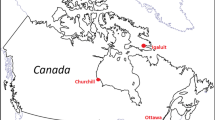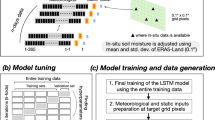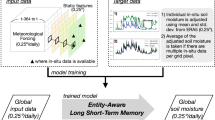Abstract
Time series modeling is a way to predict future values by examining temporal data. The present study analyzes the monthly mean soil moisture data at various depths: surface, profile, and root soil moisture, spanning from 1981 to 2022. The analysis employs two distinct approaches: the statistical seasonal autoregressive integrated moving average (SARIMA) and a deep learning long short-term memory (LSTM). The models are trained on a data set, covering the period from 1981 to 2021, acquired from the agricultural site at Andhra Loyola College in Vijayawada, Andhra Pradesh, India. Subsequently, the data from 2021 to 2022 is reserved for testing purposes. The study provides comprehensive insights into the design of both SARIMA and LSTM models, along with an evaluation of their performance using established error metrics such as the model mean absolute percentage error (MAPE), mean absolute error (MAE), and root mean squared error (RMSE). In the context of surface soil moisture prediction, the LSTM model demonstrates superior performance compared to SARIMA. Specifically, LSTM achieves a notably lower MAPE of 0.0615 in contrast to SARIMA’s 0.1541, a reduced MAE of 0.0316 compared to 0.0871, and a diminished RMSE of 0.0412 as opposed to 0.1021. This pattern of enhanced accuracy persists across profile and root soil moisture predictions, further establishing LSTM’s supremacy in predictive capability across diverse soil moisture levels.















Similar content being viewed by others
Data availability
All data generated or analyzed during this study are included in this published article.
References
Bari, S. H., Rahman, M. T., Hussain, M. M., & Ray, S. (2015). Forecasting monthly precipitation in Sylhet city using ARIMA model. Civil and Environmental Research, 7(1), 69–77.
Basak, A., Schmidt, K. M., & Mengshoel, O. J. (2023). From data to interpretable models: Machine learning for soil moisture forecasting. International Journal of Data Science and Analytics, 15(1), 9–32.
Bouktif, S., Fiaz, A., Ouni, A., & Serhani, M. A. (2018). Optimal deep learning LSTM model for electric load forecasting using feature selection and genetic algorithm: Comparison with machine learning approaches. Energies, 11(7), 1636.
Dastorani, M., Mirzavand, M., Dastorani, M. T., & Sadatinejad, S. J. (2016). Comparative study among different time series models applied to monthly rainfall forecasting in semi-arid climate condition. Natural Hazards, 81, 1811–1827.
Datta, P., & Faroughi, S. A. (2023). A multihead LSTM technique for prognostic prediction of soil moisture. Geoderma, 433, 116452.
Dimri, T., Ahmad, S., & Sharif, M. (2020). Time series analysis of climate variables using seasonal ARIMA approach. Journal of Earth System Science, 129, 1–16.
Hewamalage, H., Bergmeir, C., & Bandara, K. (2021). Recurrent neural networks for time series forecasting: Current status and future directions. International Journal of Forecasting, 37(1), 388–427.
Hipel, K. W., McLeod, A. I., & Lennox, W. C. (1977). Advances in Box-Jenkins modeling: 1 Model construction. Water Resources Research, 13(3), 567–575.
Hochreiter, S., & Schmidhuber, J. (1997). Long short-term memory. NeuralComput, 9(8), 1735–1780.
Jaiswal, A., Samuel, C., & Kadabgaon, V. M. (2018). Statistical trend analysis and forecast modeling of air pollutants. Global Journal of Environmental Science and Management, 4(4), 427–438.
Jiang, H., & Cotton, W. R. (2004). Soil moisture estimation using an artificial neural network: A feasibility study. Canadian Journal of Remote Sensing, 30(5), 827–839.
Kashif Gill, M., Asefa, T., Kemblowski, M. W., & McKee, M. (2006). Soil moisture prediction using support vector machines. Journal of the American Water Resources Association, 42(4), 1033–1046.
Kaur, J., Parmar, K. S., & Singh, S. (2023). Autoregressive models in environmental forecasting time series: A theoretical and application review. Environmental Science and Pollution Research, 30(8), 19617–19641.
Kaur, S., & Neeru, N. (2022). Machine learning-based predictions for the estimation of soil moisture content. Computer Integrated Manufacturing Systems, 28(11), 265–281.
Lara-Benítez, P., Carranza-García, M., & Riquelme, J. C. (2021). An experimental review on deep learning architectures for time series forecasting. International Journal of Neural Systems, 31(03), 2130001.
Li, X., Xu, W., Ren, M., Jiang, Y., & Fu, G. (2022). Hybrid CNN-LSTM models for river flow prediction. Water Supply, 22(5), 4902–4919.
Liu, M., & He, Z. M. (2013). Research and prediction of yellow soil moisture content in Guizhou province based on ARIMA model. In Advanced materials research (Vol. 690, pp. 3076–3081). Trans Tech Publications Ltd.
Liu, M., Huang, C., Wang, L., Zhang, Y., & Luo, X. (2020). Short-term soil moisture forecasting via Gaussian process regression with sample selection. Water, 12(11), 3085.
McLeod, A. I., Hipel, K. W., & Lennox, W. C. (1977). Advances in Box-Jenkins modeling: 2 Applications. Water Resources Research, 13(3), 577–586.
Mirzavand, M., Sadatinejad, S. J., Ghasemieh, H., Imani, R., & Motlagh, M. S. (2014). Prediction of ground water level in arid environment using a non-deterministic model. Journal of Water Resource and Protection, 6(7), 669–676.
Ouyang, Z., Zhang, P., Pan, W., & Li, Q. (2022). Deep learning-based body part recognition algorithm for three-dimensional medical images. Medical Physics, 49(5), 3067–3079.
Park, S. H., Lee, B. Y., Kim, M. J., Sang, W., Seo, M. C., Baek, J. K., et al. (2023). Development of a soil moisture prediction model based on recurrent neural network long short-term memory (RNN-LSTM) in soybean cultivation. Sensors, 23(4), 1976.
Petropoulos, F., Apiletti, D., Assimakopoulos, V., Babai, M. Z., Barrow, D. K., Taieb, S. B., ... & Ziel, F. (2022). Forecasting: theory and practice. International Journal of Forecasting, 38(3), 705–871.
Singh, S., Kaur, S., & Kumar, P. (2020). Forecasting soil moisture based on evaluation of time series analysis. In Advances in power and control engineering: Proceedings of GUCON 2019 (pp. 145–156). Springer.
Sutanto, S. J., Paparrizos, S., Kranjac-Berisavljevic, G., Jamaldeen, B. M., Issahaku, A. K., Gandaa, B. Z., et al. (2022). The role of soil moisture information in developing robust climate services for smallholder farmers: Evidence from Ghana. Agronomy, 12(2), 541.
Yildiz, B., Bilbao, J. I., & Sproul, A. B. (2017). A review and analysis of regression and machine learning models on commercial building electricity load forecasting. Renewable and Sustainable Energy Reviews, 73, 1104–1122.
Zou, P., Yang, J., Fu, J., Liu, G., & Li, D. (2010). Artificial neural network and time series models for predicting soil salt and water content. Agricultural Water Management, 97(12), 2009–2019.
Author information
Authors and Affiliations
Contributions
MTK participated in data analysis, carried out sequence alignments, and drafted the manuscript and revised it critically. MCR participated in the design of the study and statistical analyses of the data and approved the final version. Both the authors gave final approval for publication.
Corresponding author
Ethics declarations
Ethics approval
All authors have read, understood, and have complied as applicable with the statement on “Ethical responsibilities of Authors” as found in the Instructions for Authors.
Conflict of interest
The authors declare that there is no conflict of interests regarding the publication of this paper.
Additional information
Publisher’s Note
Springer Nature remains neutral with regard to jurisdictional claims in published maps and institutional affiliations.
Rights and permissions
Springer Nature or its licensor (e.g. a society or other partner) holds exclusive rights to this article under a publishing agreement with the author(s) or other rightsholder(s); author self-archiving of the accepted manuscript version of this article is solely governed by the terms of such publishing agreement and applicable law.
About this article
Cite this article
Kumar, M.T., Rao, M.C. Studies on predicting soil moisture levels at Andhra Loyola College, India, using SARIMA and LSTM models. Environ Monit Assess 195, 1426 (2023). https://doi.org/10.1007/s10661-023-12080-1
Received:
Accepted:
Published:
DOI: https://doi.org/10.1007/s10661-023-12080-1




